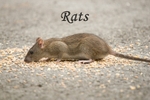Rats
• Rats can pose a severe health risk to humans as they carry pathogens which can result in disease,
including Weils disease, rat bite fever, cryptosporidiosis, viral hemorrhagic fever
• The brown rat is a true omnivore and consumes almost anything
• A rat can squeeze through a gap of just 10mm so can easily access our homes
• All rodents have a pair of upper and a pair of lower teeth called incisors. Unlike our teeth, these
incisors don't have roots, and they never stop growing! To keep these teeth from growing too long
or into their brains, rodents grind their teeth against each other or they chew and gnaw to keep
them down.
• A brown rat can breed all year round and a female can produce up to five litters a year, which can
number up to fourteen young, although seven is the average. They reach sexual maturity in about
five weeks of age so it is understandable how a rat population can grow very quickly to an
unmanageable amount if not controlled.
including Weils disease, rat bite fever, cryptosporidiosis, viral hemorrhagic fever
• The brown rat is a true omnivore and consumes almost anything
• A rat can squeeze through a gap of just 10mm so can easily access our homes
• All rodents have a pair of upper and a pair of lower teeth called incisors. Unlike our teeth, these
incisors don't have roots, and they never stop growing! To keep these teeth from growing too long
or into their brains, rodents grind their teeth against each other or they chew and gnaw to keep
them down.
• A brown rat can breed all year round and a female can produce up to five litters a year, which can
number up to fourteen young, although seven is the average. They reach sexual maturity in about
five weeks of age so it is understandable how a rat population can grow very quickly to an
unmanageable amount if not controlled.
Return to: Rats
Return to: Rats
